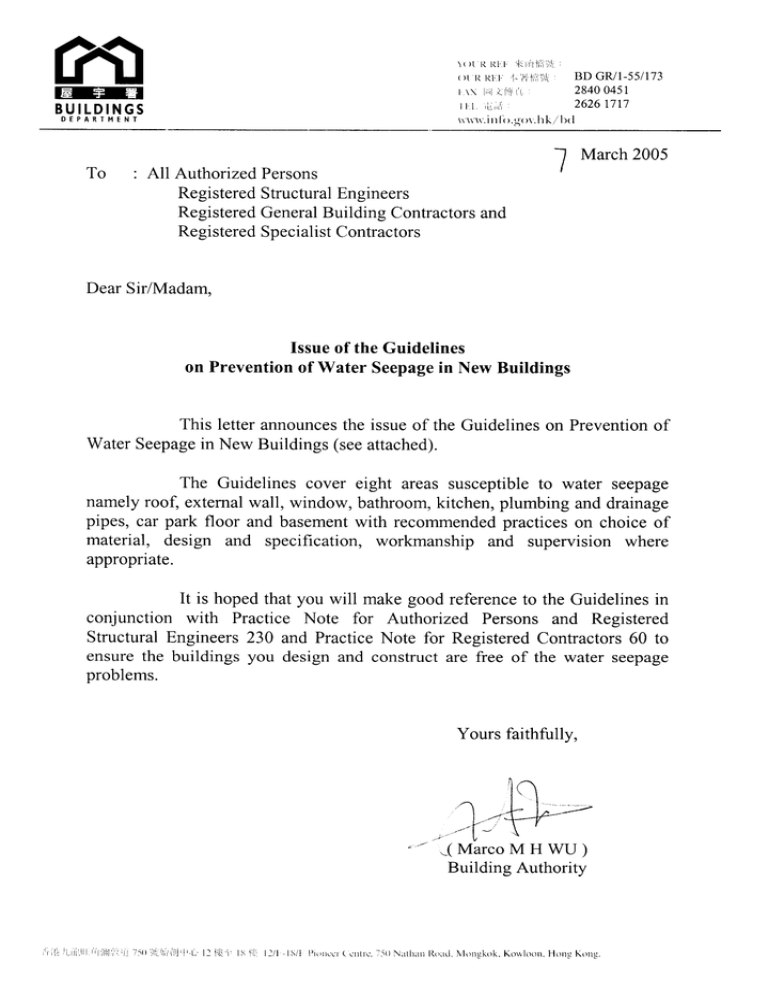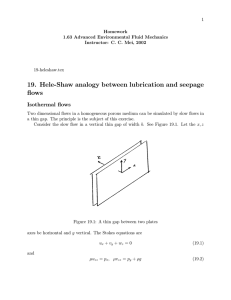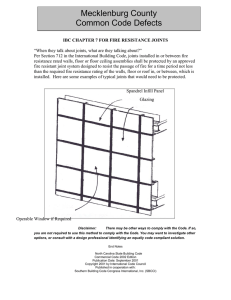Guidelines on Prevention of Water Seepage in New Buildings
advertisement

graphic: Buildings Department Your REF 來函檔號:. OUR REF 本處檔號:.BD GR/1-55/173 FAX 圖文傳真 :..28400451 TEL 電話:..2626 1717 www.info.gov.hk/bd To : All Authorized Persons 7 March 2005 Registered Structural Engineers Registered General Building Contractors and Registered Specialist Contractors Dear Sir/Madam, Issue of the Guidelines on Prevention of Water Seepage in New Buildings This letter announces the issue of the Guidelines on Prevention of Water Seepage in New Buildings (see attached). The Guidelines cover eight areas susceptible to water seepage namely roof, external wall, window, bathroom, kitchen, plumbing and drainage pipes, car park floor and basement with recommended practices on choice of material, design and specification, workmanship and supervision where appropriate. It is hoped that you will make good reference to the Guidelines in conjunction with Practice Note for Authorized Persons and Registered Structural Engineers 230 and Practice Note for Registered Contractors 60 to ensure the buildings you design and construct are free of the water seepage problems. Yours faithfully, graphic: Marco M H WU Signature (Marco M H WU ) Building Authority 香港九龍旺角彌敦道750號始創中心12樓至18樓 12/F-18/F Pioneer Centre. 750 Nathan Road. Mongkok. Kowloon. Hong Kong Guidelines on Prevention of Water Seepage in New Buildings Introduction The following guidelines to tackle water seepage at each particular area are for general reference of designers and contractors. Roof/Flat Roof 2. It is recommended that the roof should be designed in such a manner that it should not have excessive cracking or deformation under service condition. 3. roofs: It is suggested that the following guidelines be considered in the design of It is recommended that a roof be designed structurally as water retaining structure. Monolithic concrete kicker of sufficient height or even for the whole of the parapet wall is suggested at the perimeters. Adequate fall and drainage outlets should be provided to avoid ponding of water. Overflow provisions should be devised to cater for accidental blockage of the rainwater outlets. As the expansion joints are vulnerable to water leakage if not carefully designed, monolithic kickers, suitable flashing or copings and back-up drip trays should be incorporated in the design as appropriate. Where machinery is installed on roof, care should be taken to avoid damaging the integrity of the waterproofing material. Vibration of machinery can be reduced by properly designed dampers and the waterproofing membrane should be applied to the concrete plinth with plant first fixed in place. Provision of waterproofing enclosures for the electrical and mechanical services and elimination of embedment of conduits and other pipework in roof slab wherever possible will also help reduce the chance of water seepage. Proper care should be taken in designing for and use of suitable materials in the shielding or shading of openings in the external wall of services areas from possible ingress of water with due regard being given to the exposure to the elements of such areas. 4. Good workmanship plays a vital role in prevention of water seepage. Roof surface should be properly prepared, dried and cleaned before application of the waterproofing material. Waterproofing membrane should be applied in accordance with -2- the manufacturer’s specifications, and special attention should always be paid to the critical locations such as joints, upturns, downturns and penetrations. 5. Proper site supervision and relevant compliance tests such as ponding test should be carried out to ensure good workmanship and quality. External Wall 6. Junction between two adjoining buildings with improper waterproofing detail is vulnerable to water seepage. Special consideration should be given to the junctions at top and sides to prevent ingress of water. In cases where precast external wall panels are used, slotted junction detail with water bar and monolithic concrete kicker is recommended. 7. Workmanship of concreting and placing of steel reinforcement is essential in enhancing water tightness of the external walls. Proper slump, pumping and compaction of concrete as well as adequate steel reinforcement can eliminate the formation of honeycombed concrete or cracks and crevices in the walls. Well prepared and cleaned kickers, properly treated tie holes fully grouted with waterproofing mortar, good quality expansion joints with firmly fixed water bars and proper waterproofing treatment at locations of pipe penetration can reduce the possibility of water seepage. To avoid defective and detachment of external wall finishes, the adhesion between the external wall and the finishes can be improved by providing sufficient key to the substrate, specifying additives and allowing adequate expansion joints. 8. Close supervision should be provided by experienced and technically competent persons during the erection of formwork. Upon completion of the external finishes, specific tests should be employed to ascertain the integrity. Reference should also be made to the Guidelines on Building External Finishes – Tiles and Rendering circulated with my letter dated 14 November 2002. Window 9. windows: Particular attention should be paid to the following aspects in the design of Special design consideration should be given to the wall openings of the windows to prevent seepage problems. Provision of properly constructed window hood with sufficient fall can eliminate seepage due to ponding of water. Water bar should be provided underneath window frame to avoid seepage at its bottom. Proper structural design to strengthen the bottom corners of window openings and the use of trimming bars along the edges and corners of the opening can avoid diagonal cracks at the bottom corners of wall openings. -3- The window design is also crucial and particular attention should be drawn to the design of joints in window frames and sections, materials of gasket, sealant and waterproof grout. 10. Oversized window opening is one of the main causes of water seepage in windows. This problem can be avoided by accurate setting out of the formwork or by adopting re-usable metal formwork. The gap between the window frame and wall opening should be properly filled in by non-shrink waterproof grout. Besides, care should be taken to ensure that fixing of window complies with the specifications, and that the fixing does not damage the concrete wall. The wall finishes should be lapped with the window frame and sealed with suitable weatherproof sealant. Damage caused by transportation of the window and improper cleaning agent for the external wall should be avoided. 11. Quality of the window fixing work can be upgraded by close supervision, particularly during the formation of openings in walls, installation of fixing lugs and cast-in anchor. Appropriate field water test should be specified to ensure water tightness and quality of the completed windows. Bathroom 12. bathrooms: Attention should be paid to the following aspects in the design of The use of waterproofing system on the floor and walls is recommended. The waterproofing membrane/ material should cover the entire floor and turn up every wall at a height of at least 300mm. For the walls surrounding the bathtub and the shower tray, the waterproofing membrane/material should be applied to at least 1800mm high. Provision of concrete kicker as base for block walls construction is recommended. The use of galvanized steel bars to prevent the cracking of floor slab due to corrosion is recommended. Floor drains, where provided, should be sited at proper location to minimize the fall distance. Proper maintenance access to the area under the bathtub should be provided. Where other finishing material is adopted for shower tray in lieu of proprietary products, provision of suitable under-tray and/or waterproofing underlay is recommended. 13. Attention should be paid to the quality of workmanship in order to reduce defects. Suitable waterproof sealant should be applied around the bathtub and basin to the manufacturer’s specifications. Compatible protection such as the use of -4- waterproofing cement plastering on top of the waterproofing system should be adopted. During the laying of wall tiles, sufficient joint width should be allowed while excessive grouting material should be avoided. Cement base waterproofing material is recommended for adoption if tile or granite is to be fixed. In carrying out decorative works, care should be taken to avoid damaging the original waterproofing design. Kitchen 14. It is advisable to apply waterproofing system on the floor and walls of a kitchen. To prevent seepage occurring at the junctions/gaps between the worktop and the walls, provision of proper monolithic worktop with good splashback and junctions/gaps properly sealed are advisable to be incorporated in the design. Moreover, the use of exposed water supply and drainage pipes is recommended for easy maintenance. 15. The internal surfaces of the kitchen, including floor and walls should be well prepared, dried and cleaned before application of the waterproofing material. Proper gasket and sealant should be applied to the water taps to prevent water leakage. Special attention should be paid to the critical locations such as joints, upturns, down turns and penetrations. Plumbing and Drainage Pipes 16. Materials for plumbing and drainage pipes should comply with the relevant Ordinances and Regulations. For plumbing pipes, durable materials with capability of withstanding high water pressure are preferred. 17. Adequate fixing brackets and pressure reducing valves should be properly provided to prevent water hammer and vibration of water pipes, which is a possible cause of water leakage. Provision of expansion collar and good insulation for the pipes can help eliminate water leakage arising from excessive thermal movement of water pipes. It is advisable to arrange and group the water pipes inside a properly designed pipe ducts to facilitate future maintenance works. Plumbing and drainage pipes should not be embedded in common partition walls separating units and in other walls wherever possible. Reference should also be made to the advice given in Practice Note for Authorized Persons and Registered Structural Engineers 211. 18. Good workmanship is critical in minimizing the chance of water leakage. Rust-free pipe sleeve should be provided for pipe penetration to floor and wall and to be properly sealed with waterproof material as well as fire stop of the required fire resistance period where applicable. Special attention should be paid to the jointing of the pipes and drains in the course of installation. 19. Only competent plumber should be engaged for installing the water supply pipes and the whole course of works should be closely monitored by a technically competent person. Appropriate test should be employed to ensure water tightness of the completed pipework. -5- Car Park Floor 20. floors: Attention should be paid to the following aspects in the design of car park Minimizing the cracks in the car park floors is one of the effective ways to prevent water seepage. It is recommended to allow crack control in design of slabs by enhancing concrete durability such as lower water cement ratio, lower permeability and using waterproof cement; improving the reinforcement design and incorporating adequate expansion joints, in particular in the structural weak points. The car park design should accommodate the loading imposed on the floor taking into account the effect of wheel loads as concentrated dynamic loads. Provision of proprietary floor coating on the slab surface is recommended as it can give an additional barrier against the penetration of water and moisture. As car washing/cleaning activities are usually carried out inside the car park, it is recommended to allocate a suitable area(s) for car washing where the floor should be waterproof and provided with suitable fall and surface channels to properly drain off the waste water. Car park floors constructed with structural fall can allow adequate fall and avoid ponding, To prevent the surface water from flowing into the car park along the vehicular ramps, intercepting channels should be provided at top and bottom of the ramps. Car park floor slabs should also be designed to fall away from the ramps. As water seepage often occurs at the movement joints in car parks where kickers cannot be effectively provided to finish off any waterproofing membrane near the movement joints, suitable water-stops should be provided with proper sealant on top to prevent water seepage. Location of movement joints should also be avoided in low points in the floor. 21. A water seepage free car park requires good workmanship. Contractors should strictly follow the specifications and procedures of concreting as required by the designers, and pay good attention to each stage of operation viz. installation of steel reinforcement and spacers, compaction and curing. 22. Proper site supervision must be carried out to ensure good workmanship and quality. Ponding and other compliance tests are recommended to ensure water tightness in those areas that may be subject to wet activities. -6- Basement 23. Proper waterproofing materials should be selected for the basement taking into account its location and topographic characteristics. 24. basements: Attention should be paid to the following aspects in the design of As basement floor and walls are usually subject to moisture and even sub-soil water, it is advisable to design the basement (excluding pile caps, thick footings and diaphragm wall panels) structurally as a water retaining structure with added provision to allow for proper diversion of ground and penetrating water in the event of water leakage. The sequence of construction should be carefully examined in the design stage to avoid defective tanking and water seepage at construction joints or locations of temporary supports. As water seepage often occurs at the construction joints and the locations of temporary supports of the basement walls, suitable water stops should be provided at these locations to prevent water seepage. A cavity wall system with surface channels should be considered to divert ground and penetration water to the drainage system of the subject building. The use of hardcore/filter or suitable proprietary products can help reduce the build-up of water level and hydrostatic pressure. 25. If external tanking is used, it should be maintenance free since it is difficult to rectify a defective basement tanking after backfilling. Thus, backfilling works should be carried out only after a satisfactory water test for the tanking and extreme care should be taken to avoid damaging the waterproofing system. 26. Good quality supervision is crucial for construction of basement. The supervision personnel should closely monitor the construction activities during the course of work. Concrete should be delivered to the bottom of the wall by suitable means and dropping of concrete should be strictly prohibited. Suitable access for the concrete vibrator should be allowed for even compaction. Buildings Department March 2005





